 [Home] → [Records] → [Drescher Inlet]
[Home] → [Records] → [Drescher Inlet]
Expedition to Drescher Inlet on the East Coast of the Antarctic Weddell Sea
Prologue
1. Training in the Alps
2. Journey into the ice
3. At the Atka Bay
4. Arrival at Drescher Inlet
5. On the first day
6. New day, new luck
7. The storm
8. Dive into the unknown
9. The way home
Epilogue
Further reading
Prologue
Although I had already made several trips to the Antarctic waters of the Weddell Sea, this one was to be a very special experience. While I had previously deployed the ROV (Remotely Operated Vehicle) in a vessel-based setting, our destination in December 2015 was the mighty Riiser-Larsen Ice Shelf on the east coast of the Weddell Sea. The plan: to establish a camp for four people and pursue our research project from the ice for a month. However, despite some experience with organisation, coordination and camp life, this project presented me with particular challenges. We spent more than a year preparing, acquiring and building the required equipment, completing all the necessary formalities, taking medical fitness tests and preparing ourselves mentally and physically for the rigours of the journey. Finally, we were dropped off in an ice desert and found ourselves not even on solid ground, but floating on water that was about minus two degrees cold. This is so cold that even a fall into the wet blue can lead to shock and immediate cardiac arrest. To prepare us for the adversities and all eventualities of the trip, we had to complete a preparation course in the austrian Alps.
1. Training in the Alps
So the day came when we set off for Austria. First we took the train to Innsbruck and then the bus up into the mountains. After a night in Obergurgel and a quick breakfast in the hotel, we continued on foot into the high Alps. Initially still dominated by civilisation and pastures shaped by the charm of the mountain farmers, the landscape changed after a while, turning into a densely overgrown bush landscape dominated by trees. We passed a variety of sweet-smelling plants, colourful blossoms and listened to the sound of the inhabitants of this idyll.
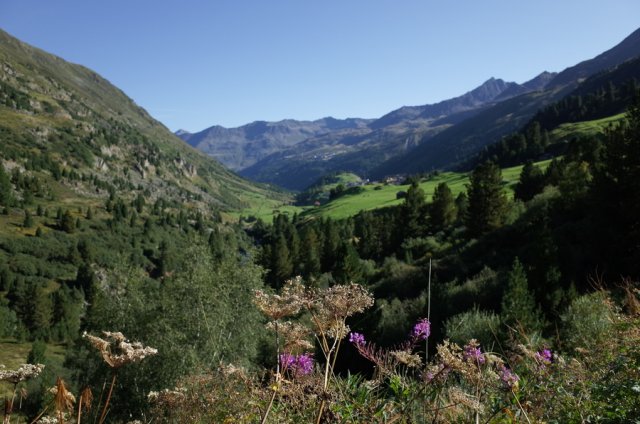
View of the Obergurgl valley. Picture: Horst Bornemann
We left the shady mountain forests after a few hours and crossed the vegetation border, over which we entered a completely different world. A line as if drawn with a ruler separates Lothlórien here from a rugged, shadowless rocky desert of Mordor, bathed only by sparse patches of grass in a shimmering green. With that, however, the visual horizon expanded, revealing an unobstructed view of the valley and the white-sugared ridges of the mountains. As a friend of the mountains with a life in one of the flattest regions of our country, I am always overwhelmed by the three-dimensional, Lilliputian model landscape revealed to the viewer from a bird's eye view. Our first stopover, the Langtalereckhütte about halfway up to the glacier, offered us accommodation and delicious home-cooked food made largely from home-grown products. The day was not over yet and there was still enough time to start with a little theory and some climbing training in abseiling and securing before we headed off for a good night's sleep after a tough start. After breakfast the next morning, which was in no way less tasty than the previous day's hearty meal, we set off on the next section of our mountain climb. The initially greenish areas faded with time and were replaced by shades of grey. From here on, only very sparse life was possible. The sun burned down mercilessly from above and shady spots were few and far between.
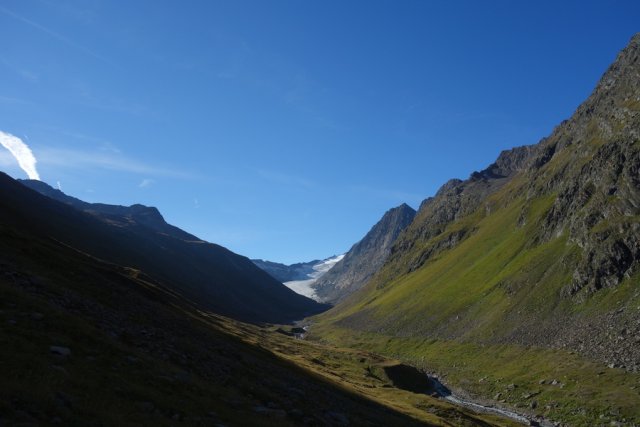
View up to the Gurgler Ferner.
After some time, we finally reached our destination, the Hochwildehaus, a small but very inviting accommodation at an altitude of almost three thousand metres on the edge of the Gurgler Ferner with a wonderful view over the glacier landscape. At that time, various supports were already in place for the aging building, which made a charmingly nostalgic but unfortunately also somewhat dilapidated impression, which probably inevitably pushed the owners to abandon this domicile later on.
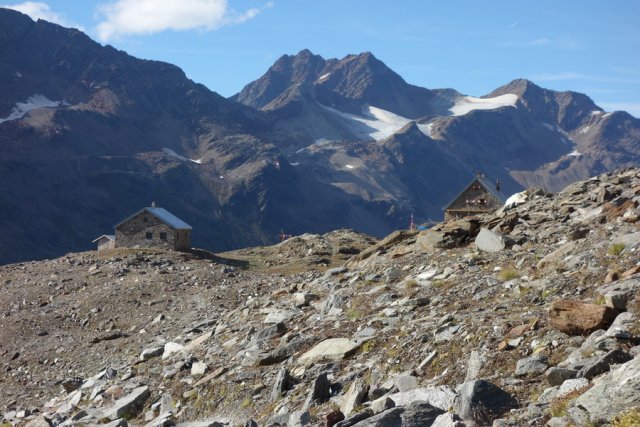
The Hochwildehaus on the right and the old toll house on the left on the edge of the Gurgler Ferner.
This is where our actual training was to begin. Without letting much time pass, we started our exercises in the use of ropes, carabiners, ice axes and crampons, necessary skills to face the challenges of the glacier.

Panoramic view over the Langtaler Ferner to the south and up to Annakogl (right). The view from about three thousand metres above sea level reaches as far as Italy.
As the owners of this location were the same as those of the Langtalereckhütte further down, breakfast the next morning was just as sumptuous and delicious as the day before. As time was pressing, we got ready to leave as soon as possible. Like the seven dwarfs in a row, tied together as a rope team, we headed towards our training location, an ice edge to the neighbouring Langtaler Ferner. It was one of the warmest days since temperature records began, so although everyone had already taken off their jackets and jumpers, we quickly began to sweat. The weather was also hard on the ice beneath our feet, which was noticeable in the endless rivulets and extensive patches of water on the ice. Under such conditions, the glacier would probably not be able to hold out much longer. This did not make our situation any easier either; the melted surface was mirror-smooth in places and only our crampons prevented us from being transported directly back down into the valley. I had the most respect for the hourglasses, conical holes in the ice in which the water disappeared into the depths of the glacier like in a whirlpool drain. Just the idea of disappearing into such a hole and getting stuck like a cork in a bottle neck caused a queasy feeling in the pit of my stomach.
Arrived and a snack later, our preparations for the emergency began. Among other things, we learned how to bury a dead man. This was not meant literally, of course; instead, it is a safety technique in which an ice axe is buried in the snow and thus forms the last safety device in the rescue chain. With this net and double bottom, we were instructed in the fine art of crevasse rescue. So we gradually changed the order of our rope team and let the respective pole position loose on the abyss until he disappeared into the depths, usually with a bloodcurdling scream, followed by all the colleagues who came after him, unravelling loop after loop like a woollen thread being pulled out of a garment. The procedure in such a case actually requires some experience, everything happens so fast that thinking already takes far too long. Throwing the legs forward and digging into the snow, always hoping not to tip over to the front. That everyone has to pull together in the process is probably pointless to mention, because there is no other choice. As soon as the movement from the rocket-like acceleration has come to a standstill, the aforementioned dead man must be buried at the end of the chain, securing the team and allowing them to take a breath. The person in front who is still on the surface - hopefully number two in the line, otherwise it will be critical anyway - can now free himself from the chain with a clever lashing technique and set up a rescue system. This is a kind of pulley, which is assembled from ropes, slings and carabiners. How the rescue is carried out depends on the physical condition of the person who has fallen and is still hanging from the rope. If the person is responsive and able to actively cooperate, the strenuous act of rescue begins immediately. Here it becomes clear once again what effect potential energy has on our lives. If this is not the case, the task is complicated by the rescue of an injured or unconscious person. In order to retrieve the body hanging like a wet sack from the end of the rope, number two must first abseil down, give first aid and prepare for the rescue. This doesn't make it any easier for the remaining rope team members, but fortunately the human body releases unimagined forces in such extreme situations. After we had played out a few scenarios and our strength was pretty much at an end, we finally made our way back home to the Hochwildehaus.
The unusual weather conditions continued into the night, I would almost call it an event of the century. A crystal-clear sky and the full moon bathed the glacier in bright moonlight, while it was also unusually warm at 15°C. It really didn't take much persuasion to convince our instructor that this was the perfect opportunity for a night climb of the over 3300 metre high peak of the Annakogel at the edge of the glacier. Unfortunately, and I still mourn the situation to this day, such an undertaking was not possible in this context. This definitely belongs in my top 10 list of things I should have done and did not do…
Before we started our descent into the valley the next day, we took a close look at the survival equipment, as this is part of every venture into the eternal ice of Antarctica.
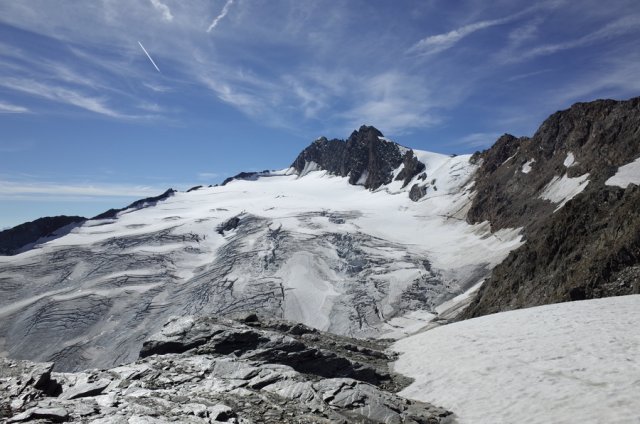
The Annakogl at an altitude of over 3300 metres. Picture: Horst Bornemann
2. Journey into the ice
A few months later, all preparations for our campaign were completed. The cargo had already been delivered to the Polarstern and was on its way south, we had passed all medical fitness tests, were equipped with polar gear and mentally prepared for our journey. A slightly queasy feeling came over me when we were advised, purely prophylactically of course, to prepare a will. This underlined, despite all the euphoria, the risks associated with the trip. Nonetheless, the doubts connected with this quickly faded away and were lost in the anticipation of our adventure. After a short stopover in Munich, the first stage of our long journey was the sunny and warm Cape Town at the southern tip of Africa.
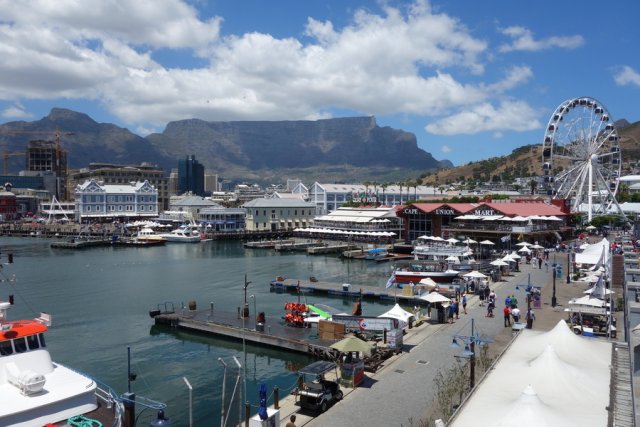
Cape Town with view over the Waterfront, the harbour promenade and the city's landmark, Table Mountain.
Since work in Antarctica is only possible in the southern summer, we set off in December 2015 and reached the last tip of the mainland in mid-summer. Until now, the journey was no different from other expeditions, but from then on everything was to be different. While in the civilised regions of the world the weather can still be predicted well, and planes and airports are equipped with a variety of technical systems that allow flying and, above all, landing even in adverse weather conditions, things are very different in Antarctica. Time schedules there are heavily dependent on the whims of nature and can quickly upset one's schedule. You should therefore always plan enough time in reserve to avoid unpleasant surprises with your connection options. Our travel plan was to fly by plane from Cape Town to Novolazarevskaya, the hub on the Antarctic coast. From there we were to continue by plane to the Antarctic station Neumayer III, where we would be picked up by the research vessel Polarstern and finally dropped off at Drescher Inlet. With a generous amount of buffer time, we spent a few days in Cape Town, which gave us enough time to organise and prepare for the onward journey.
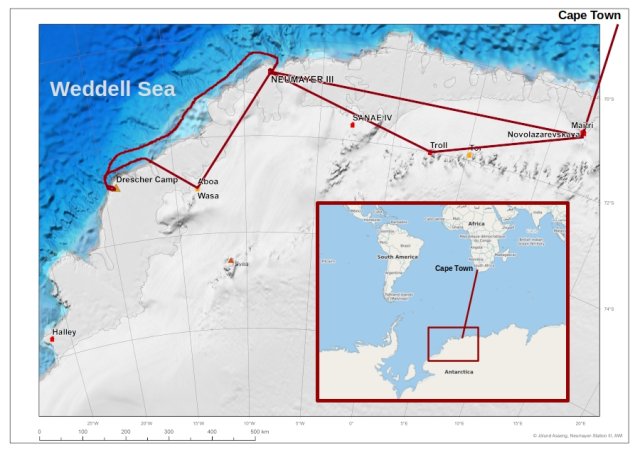
General map based on IBCSO v1 (International Bathymetric Chart of the Southern Ocean) and Open Street Map. The red line shows the route from Cape Town via Novolazarevskaya, Neumayer III to Drescher Inlet and back via Aboa, Neumayer III, Troll, Novolazarevskaya to Cape Town.
It was a bit bizarre to read Antarctica on the airport's display board among all the cities served from Cape Town. Our plane, a Russian Ilyushin, the Volga Dnepr, was already waiting on the airfield. The imposing transport plane has the wings with the four impressive engines above the cargo hold - wait, cargo hold? Until that moment, I hadn't realised what I was actually getting myself into. To my reassurance, there were at least seats. I had already imagined a flight where I would be strapped somewhere between the cargo. The porta-potties behind us, strapped down with tension belts, also made me smile a little. There were no windows, only aisle or middle seats, but at least there was a large screen showing the image of a camera with a pilot's view to the front. I understand the fear of importing native plants abroad, so we all had to take a Kneipp cure in an indefinable pink liquid before boarding, but honestly, if it were possible to grow apples from the seeds in my shoe profile in Antarctica, I would have a lucrative business idea. While this only made me wonder, I was a little startled by a very different fact. We were actually the only people on board with a work assignment. The miserable footprint we left behind made me feel sufficiently guilty as it was. However, the other roughly two hundred passengers were tourists on a short trip for a day or two in the ice. If we continue like this, I don't think we have a good chance for the future. But the fact that we were flying in the cargo hold of a transport plane over the Southern Ocean and would be landing on a vast expanse of ice immediately redirected my concentration back to our adventure. We were facing a six-hour flight directly south, which in the event of an accident would probably offer no chance of survival for crew and passengers. From the South Polar Circle onwards, water temperatures drop below zero degrees Celsius, which triggers a shock and associated cardiac arrest in most people as soon as they dive into the cold water. Besides, there is no question of quick help down there in the first place. At least the adverse flight saved us a ten-day sea voyage through the roughest waters in the world. I myself have already made several of these crossings. The highlight was definitely a low-pressure system with less than nine hundred hectopascals, which led to wind speeds of over one hundred and forty kilometres per hour. That is beyond Beaufort scale twelve and brings with it waves of over ten metres. In plain language, the alternative boat trip could have meant a week of roller coaster riding without an emergency stop. I could well do without that.
The flight was quite calm, we had the best cloudless weather and soon the first icebergs came into view, which continued to thicken until they finally merged with the Antarctic coast. Then the runway came into view - well, in view is putting it mildly. A white stripe on a white background, only slightly shaded from the rest of the surroundings, as if the polar bear's fur had been brushed against its direction. Personally, I find the idea of landing a several hundred tonne wheeled aircraft on a patch of ice very suspect. Anyone who has ever had the experience of icy roads can certainly understand this. But our pilots are either great daredevils or shrewd professionals. Finally, they landed the steel bird safely on the icy runway and we were allowed to leave the plane before anyone else because of our special status as scientists. The walk from our seats in the last row, past the rows of people, added a bit of euphoria and VIP feeling to my joy of the safe landing.
Novolazarevskaya is the central hub airport in this part of Antarctica, comparable to London Heathrow in Western Europe. There is a regular outward and return connection to Cape Town, while smaller aircraft take over the onward journey or transport to the most diverse stations. Because it is only possible to fly here on sight and thus only during the day, the station, which is made up of a countless collection of containers, is only operated in summer, because once the Arctic Circle has been crossed, the rules of day and night in the 24-hour rhythm no longer apply here. Due to the excellent weather conditions, which can change quickly and unexpectedly here, we were transferred directly to our connecting flight to Neumayer III. A flight that would take another three hours and depend on both the weather at departure and the conditions at the destination. It was a bit like playing the lottery, even if all seemed perfect at that moment, everything could change within the following flight time. Because if clouds form in Antarctica, which can happen within minutes, the sunny ice idyll turns into a grey soup without contrasts, up to the so-called whiteout. Then the ice can no longer be distinguished from the sky, the horizon dissolves and you quickly lose your orientation. If there is also wind, it gets even worse. The snowflakes lying loosely on the surface can be whirled up into a blizzard-like storm, so that it feels as if a huge snow globe is being shaken and you are in the middle of it. Visibility can then be reduced to a few metres and without any clues there is no chance of seeing even the shelter a few steps away. In such a case, the only option is to stay in place and sit it out, if only it weren't so cold. Flying, not to mention landing, is then impossible, so we had to get our luggage quickly to a DC3 and continue our journey as soon as possible. Colleagues have already been stuck at the station for four weeks because of such a change in the weather.
The DC3, an old aircraft from the Second World War era, gained its fame as a candy bomber through its missions as part of the Luftbrücke (airlift) to Berlin. After some upgrades and extensive maintenance, some of these aircraft are actually still in service today. It is the largely mechanical technology that, with a few exceptions in the cockpit, ensures their reliability under the harsh environmental conditions in the polar regions. It may be a coincidence that so far I have only met Canadian crews flying DC3 type aircrafts beyond the Arctic Circle. Presumably the Canadians are used to dealing with such machines and the high art of manual flight school from their home Arctic. It wasn't long before we were back on the runway and cleared to fly to Neumayer III, our Antarctic outpost on the edge of Atka Bay at the north-eastern tip of the Weddell Sea. The flight went without any major adversity, but clouds came in and blurred the view. No cause for alarm yet, but it was clear that the contrast between the sky and the ice was diminishing noticeably and at some point landing would become a game of blind man's buff. Accordingly, I was glad when we finally had ice under our feet again.
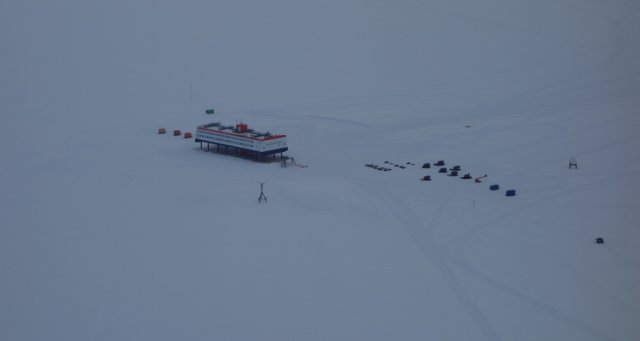
Landing approach to the German Antarctic station Neumayer III of the Alfred Wegener Institute on the edge of Atka Bay.
3. At the Atka Bay
A warm welcome awaited us, after which we were led to our accommodation, which would offer us shelter for the next few days. As there is a lot going on here in the summer months, exchange and handover of the station crew, various scientists but even more technicians who are mostly busy with the maintenance of the station, the accommodation was completely occupied and we moved into a small, spacestation-like dwelling outside. There were four sleeping places, which could only be reached by climbing over the sitting area in the middle, and a small entrance area, which was just enough to turn around. In 2009, the third generation of the Neumayer station was put into service for German Antarctic research under the direction of the Alfred-Wegener-Institute. Its currently unique design allows it to be raised via hydraulic feet. This technique allows it to free itself from the snow accumulated by precipitation and drifts, which would otherwise slowly but surely bury it. The station stands on sixteen posts, which are raised by about a metre when needed, underlaid with snow and ice, and can eventually lift the colossus synchronously. This prevents the station from sinking steadily, but not from its constant drifting with the flowing ice shelf, which moves towards the coast at about half a metre per day. So it has an inevitable best-before date when it reaches the coast after thirty years. Until then, however, the station will be in operation all year round. While there is a lot going on in summer, in winter it is only a crew of nine that gets the Antarctic outpost through the dark and cold season. It serves as a base for various scientific, but also non-scientific tasks. Geologists, glaciologists, as well as biologists come here to do their field research, which either takes place in the immediate vicinity of the station, or they use the station as a base camp from which expeditions into the eternal ice are undertaken. There are also some very interesting cooperation projects with other institutions. Although the project of the German Aerospace Centre (DLR), which operates a greenhouse container to grow food under hermetically sealed conditions like those prevailing in space, there are also less popular projects. One important function that the Federal Institute for Geosciences and Natural Resources (BGR) performs is to monitor the international agreement to refrain from testing nuclear weapons. In addition, the German Weather Service has a field office on Neumayer III that provides data for air and shipping traffic in the region.
Actually, we were only supposed to spend a few days at the Neumayer station before the research ship Polarstern would pick us up and take us to our destination - the Drescher Inlet - but down there a lot of things can only be vaguely planned. It was not the weather conditions that forced us to take a break, but the ice conditions. Although Polarstern appeared on the horizon right on time off the coast of Atka Bay, the unusual sea ice conditions made access to the ice shelf impossible. Since their reason for stopping at Neumayer was not only to pick us up, but primarily to supply the station. Normally, the entire procedure could also be done from the sea ice, but as always, the whole thing had a small but crucial catch. Among other things, the station is also supplied with fuel and the liquid, which is declared as an environmentally hazardous substance, may only be dumped on the safe ice shelf. Since this energy source is essential for survival during the long, cold and dark winter, a solution was needed. It didn't take the experienced captain of the Polarstern long to get the situation under control. He manoeuvred the ship in incessant circles, like a giant milling machine, scraping part of the ice from the surface with each rotation. It was a clever plan that worked, but it took a very long time, so our stay was extended by about ten days. We were worried whether we would even reach our destination under these circumstances and started to work out an alternative plan. This plan was to move the scientific work to Atka Bay and we spent the days exploring the area to find suitable places for our ROV missions and to find the favourite spots of the seals. In the process, we had the opportunity to observe the incessantly circling Polarstern again and again. In good weather, the scenery appears so peaceful, a brilliant white idyll that in the night sun, when it is lowest over the horizon, turns into a pink backdrop of manifold colour variations and elongated shadows. A multitude of actors gambol around on the stage of Atka Bay, which is surrounded in a semicircle by an ice shelf wall about ten metres high. Wherever the ice surface is interrupted by cracks, Weddell seals have the chance to leave the water and gather in small groups to take their siesta in the shelter outside the water, for danger only exists for the animals of Antarctica in the wet. A myriad of Emperor and Adélie penguins form aggregations of varying sizes and enrich the area with their chattering conversations, which can be heard from afar. They often travel many kilometres to reach the sea, because no one can find food on land here. Waddling cutely or sliding on their bellies, they move in small groups along invisible paths. The sky is dominated by birds, most of which are only summer visitors like us and leave the cold continent in winter.
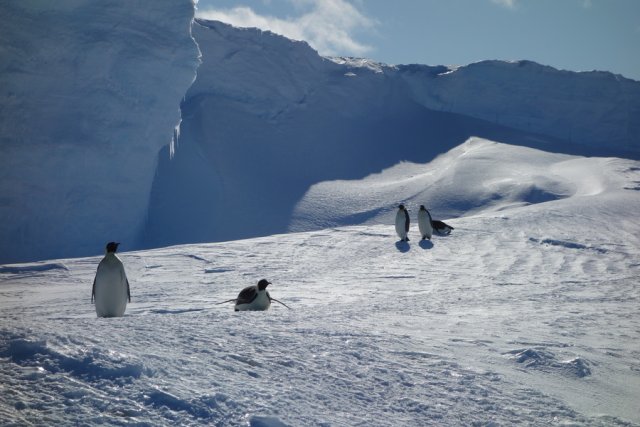
A small group of emperor penguins making their way on the sea ice along the ice shelf wall in Atka Bay.
The sea ice that has accumulated in the bay decreases in thickness towards the ocean and finally ends at the open water, although it is still so thick that it seems unlikely to break in. However, the various crevasses in the ice pose a real danger. Wind, tidal and ocean currents push and pull at the mighty floes, and the crevasses open and close during the day like pulsating veins. At the edge, detachments occur now and then, sending individual floes on their journey with the currents. A careless or reckless person who ventures too far out runs the risk of having only bought a one-way ticket. This is one reason why excursions on the ice are only allowed with appropriate survival equipment, radio and satellite phone. Before leaving the station, activities must be authorised and conscientiously documented in the logbook, including the estimated time of return. If someone forgets to report back, or is beyond the predicted time of re-entry, a state of emergency is immediately declared here and search teams are sent out.
When the weather is nice, it's easy to forget the dangers that lurk out here. Thanks to the immense hole in the ozone layer, which is also located directly above the South Pole, the sun burns mercilessly from the zenith and is almost completely reflected on the white surface. The oversized solarium can only be endured with sun protection factor 50+, but the sunlight not only brightens up the landscape, but also your own mind. Atka Bay itself is not particularly deep, so it happens time and again that passing icebergs get stranded. Once part of the seemingly endless ice shelf, they break off at the coast at the end of their millennium-long journey in the ceaseless flow of the ice masses and drift away with the ocean currents. Some of them make their way back, not finding enough draft in these shallow waters. If they are not torn loose again by the tides, they are enclosed by the sea ice and form small islands that create graceful contrasts to the otherwise relatively dull ice surfaces. After about a week, we had explored Atka Bay extensively and had made an alternative plan in case we were unable to continue our journey. But luck was with us. The Polarstern finally made it to the north-east jetty, a tongue of ice at the western end of the bay, whereupon the loading work began immediately. Now it was time to gather up our things in a hurry, jump onto one of the pistenbullis and off we went to our next leg of the journey. A somewhat confusing hustle and bustle took place on the ice and on the ship, but it seemed to be coordinated and before we knew it we were part of the big barter trade that was going on between the supply ship from the far north and our outpost. A little concerned of the ice conditions that had already caused the delay in docking, we left the last patch of civilisation and headed south, into the perpetual ice of the Weddell Sea. Basically, this section should not take more than thirty-six hours under ice-free conditions, but our fears were unfortunately exceeded, although the most critical point was still to come. Unfavourable westerly winds were pushing the ice masses that cover the Weddell Sea all year round and only break up in a few places in summer, onto the east coast, closing off its large polynas, as the open water points surrounded by ice are called. Actually, this is not a big problem, the crew and the ship have mastered such situations many times before, but this circumstance delayed our journey once again. The planned one and a half days turned into about a week in the end, during which we had to break our way through thick ice fields.
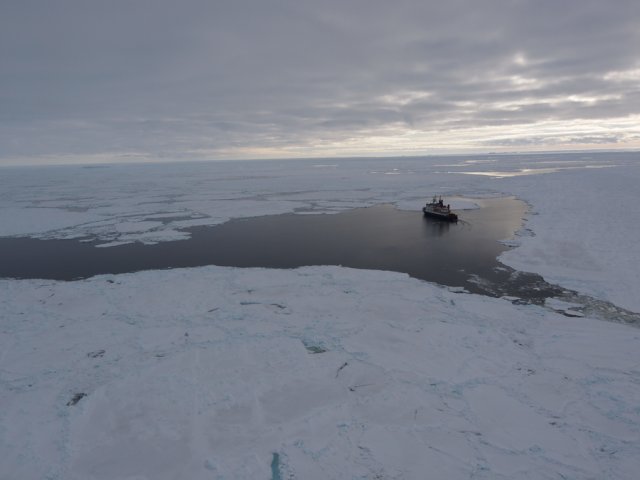
Polarstern on its way through the Weddel Sea. Image: Horst Bornemann
At times, there was no progress at all and the ship would ram forth and back, like a seal, to keep an ice hole clear so that we wouldn't freeze completely. The ship's GPS track took on the most bizarre shapes in the process. Since the ice itself drifts constantly with tides and currents, this created a sawtooth pattern. Only when Neptune was kind to us again did we make progress. Meanwhile, our schedule was getting tighter and the scope for scientific work was steadily shrinking. Finally, we had only one day left to unload all our cargo in the Drescher Bay, a nerve-wracking procedure of countless flights with two helicopters that would fly the approximately ten tonnes of equipment as an external load to our destination about fifteen kilometres inland. Up to this point, however, it was not clear if the weather would cooperate at all and if we would even make it close enough to the inlet. In any case, nothing works here without the good will of nature. At least we were able to enjoy the amenities on board, the wonderful view into the vastness of the ice desert as well as a great Christmas and New Year's celebration…
4. Arrival at Drescher Inlet
Then all of a sudden, almost unexpectedly, we reached the long-awaited place of our venture. The weather was merciful to us and suddenly things got hectic again. There was no time to lose, because no one could predict the vagaries of nature here. The conditions, which until then had been perfect for the risky flight manoeuvres, can change quickly. We were flown with a selected group first to a spot on the ice shelf safe enough to set up the camp but also close to an ice ramp that led onto the sea ice some twenty metres below. This was on the outer edge, in the bend of the L-shaped inlet, which looks like a river channel from the air, but is actually the broken up ice shelf that is slowly and unceasingly disintegrating on the shore. three kilometres wide at the opening. Its shape, bordered by high ice shelves that drop down to one hundred metres depth, encloses the sea ice, which only partially dissolves in summer. Most of it, however, remains closed all year round and offers an ideal area for research. But we are not there yet.
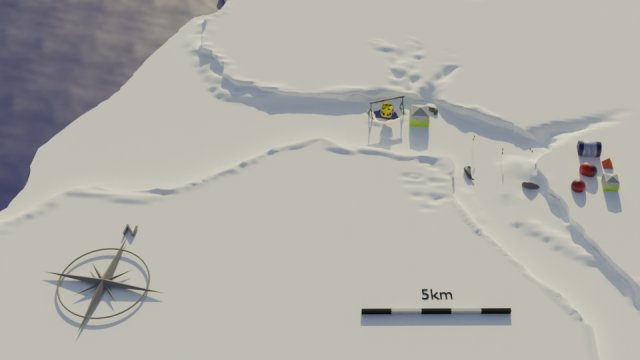
The Drescher Inlet
First we had to set up the base for our venture. While we began building the camp, the helicopters flying in had to be constantly instructed with their external load. We did not have much time to lose, because, as already mentioned, the weather was not allowed to change. In such a case, the flight operations would have to be aborted, and without our complete equipment, a longer stay out here would be impossible. In addition, the camp had to be prepared in such a way that we would at least have a sheltered dwelling for the night. Under the deafening noise of the rotor blades and howling turbines of the two helicopters, which flew their circles incessantly, nets with luggage, equipment, food, generators, tents, two GRP igloos, three snow scooters, lots of fuel, the entire ROV system including a heavy-duty crane, Nansen sledges and much more were brought in. In the end, it took about thirty flights to get everything onto the ice. I can't remember how many hours we spent flying back and forth, coordinating everything we needed and doing everything we couldn't have done without the crew we were given, because once they fly out again, we have to manage on our own.
The work in the camp went according to plan. We were still assembling my accommodation, a semi-tubular tent about fifteen square metres in size, into which I moved with all my equipment. When everything was ready, our companions were flown out one by one. We watched the Polarstern for a while longer, until it too disappeared on the horizon and we were finally on our own. Now it became quiet around us...
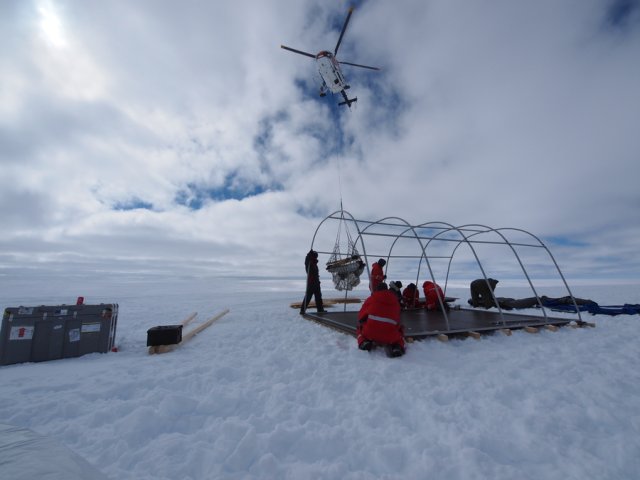
Setting up my accommodation while the helicopters tirelessly fly in more equipment. Picture: Horst Bornemann
I think it is about time to introduce our team. First there was Horst, the head of our company, a seal enthusiast who is interested in the behaviour of Weddell seals, which are found here en masse. Fortunately, Horst is not only an enthusiastic scientist, but also a veterinarian. So we had at least one person with basic anatomy knowledge in the team, because we could not count on outside help in an emergency case. His scientific mission was to conduct behavioural research on Weddell seals, their migration areas and food sources. His plan was to equip the seals with GPS transmitters and cameras to record their diving, hunting and movement patterns. The data can then be used to derive behavioural strategies and information about the ecosystem's food chains. Our second soul of the team was Richard, an old hand in our business. As far as I know, he had already set up and managed camps on the Antarctic Peninsula. His part in this mission was camp management. He kept our base running, took care of the technology and made sure we didn't want for anything. Dominik was a student and assisted Horst in his work. His hand was always and everywhere. Tirelessly he helped at all ends and was always at hand when you could use his support. I must admit, I was seriously impressed by his dedication without complaining even once. Of course, this is only a brief summary of our team and does not even begin to reflect the commitment that had to be made every day. With only four people, you have to rely on each other and help each other as much as possible. In the end, the duties were not so strictly divided and everyone stood in for everyone else. And then there was me. I had the ROV in my luggage and was largely responsible for all the measurement technology. The idea was to saw a hole in the sea ice and steer the robot from there under the thick ice shelf. In past expeditions, Horst had recorded small creatures living on the underside of the ice. The pictures had been taken by transmittered seals and unfortunately were not of very good quality. It was not possible to identify exactly what species it might be, only that something was living there. With the ROV, we wanted to make high-resolution video recordings and take samples. Since the seals had already approached these organisms and their dive patterns showed significant residence times at its depth, so it might be a potential food source. However, as we would later discover, this endeavour proved more challenging than expected.
Speaking of food sources: We had planned a huge stock of food for at least twice the duration of our stay, which would certainly have been enough for four months if we had been on strict rationing. Besides the usual products that had a shelf life of more than a week, there were tons of ready-made foods. Small bags with all kinds of dishes that you could simply heat up in a water bath. We cooked noodles, rice or potatoes with it. There was even a deep fryer where we could regularly prepare crispy snacks. After heating up, the smell from the device was like from the kitchen of a snack bar, which must have been quite noticeable considering the few smells that originated in this ice desert. In any case, a crowd of skuas - the pigeons of Antarctica - gathered in front of our camp every time we dipped chips, onions or similar into the hot oil. The otherwise seldom-seen birds seemed to notice even the smallest trace of our cooking in the distance and tracked it to its source. It was a mystery where the skuas otherwise passed the time, either flying long distances or having a secret hiding place just around the corner and watching us, always ready to strike when an opportunity presented itself.
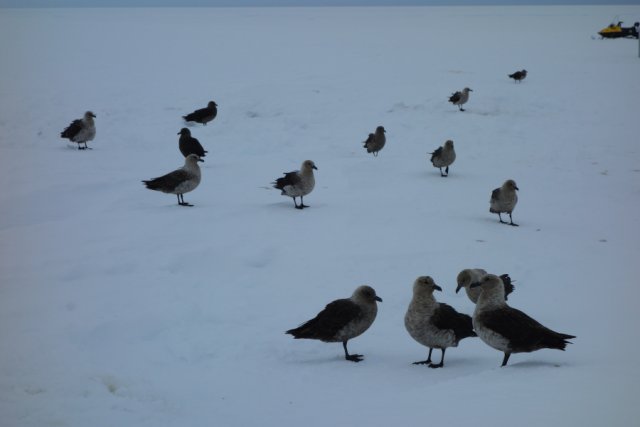
A flock of Skuas, unerringly guided to the camp by the smells of our galley.
The few products that were edible without reheating in the prevailing temperatures here were only available in limited quantities. One might think that this would be the ideal environment for frozen products and that with an average outside temperature of about minus ten degrees Celsius everything would have to freeze into blocks of ice. However, this is not the fact, strangely enough, the opposite is even the case, it is practically impossible to keep anything permanently in a frozen state, which is why we had not taken any frozen food with us. The reason for this absurd fact is quite simply the merciless solar radiation, which is sufficient even under cloudy skies to warm everything that is not made of ice and snow to above zero degrees Celsius. While the glaring light is almost completely reflected by the white surface, everything else soaks up the almost infinite energy of our central star like a sponge and converts it into heat. The curious thing is that even burying the food does not help, as the radiation penetrates deep into the ice and seeks out the darker objects there as well. Apart from the fact that this involves considerable effort and has little chance of success, everything slowly melts into the ice anyway. The stronger the solar radiation, the warmer the objects become and the faster they sink. In the end, we had to break everything out of the ice again with a lot of effort that we had not moved regularly.
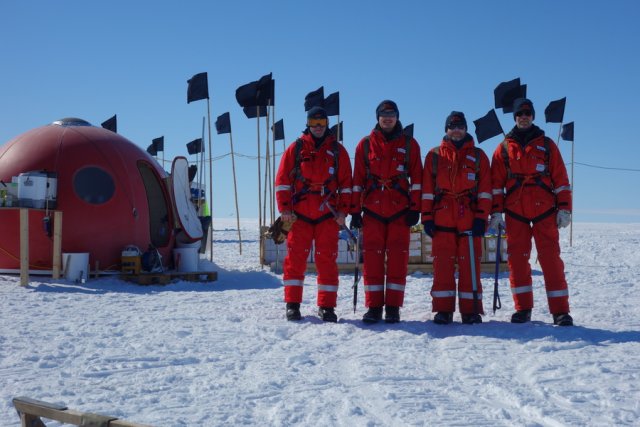
Our team shortly before setting off for the first ice exploration.
Nothing but white plains stretching in all directions to the horizon and I slowly became aware that we really were at the end of the world here. The nearest stations were Halley in the south by the British, Aboa and Wasa by the Finns and Swedes in the east and Neumayer in the north, but they were all several hundred kilometres away and unlikely to be reached by snow scooter. Help would take several days, if the weather allowed it at all. Planes could not land here because there was no prepared runway. If I had understood correctly, there would be a rescue plan in case of emergency, which included evacuation by helicopter. The South Africans have transport helicopters, but their range is very limited. They would set up a chain of stations, stockpiling fuel and working their way from station to station. Again, this is highly dependent on the weather and would definitely take a couple of days under optimal conditions. For this purpose alone, we had taken six hundred litres of aviation fuel with us in order to be able to speed up an evacuation at least a little. So it seemed better to me not to get into a precarious situation in the first place. My fears and worries quickly faded under the overwhelming scenery that presented itself to us. When the beeping in my ears, caused by the incessant noise of the helicopters, finally faded, I realised that it was not as quiet as it seemed at first. Futuristic sounds like something out of a science fiction film, howling frequencies that travelled through a broad spectrum of tones, penetrated my ears. As I was to discover later, they were Weddell seals and their, to my interpretation, feel-good sounds. They had gathered by the hundreds in Drescher Bay to rest and be warmed by the sun. They only have enemies in the water, which makes them very relaxed companions on the ice. In summer, this is the perfect place for them to hang out and raise their offspring. Weddel seals are among the best long-distance divers, at least among their fellow species. That is why they have made it so far into the Inlet. Their hunters can't or don't dare follow them, because the cracks in the ice that allow them to stop for a breath of air can also close up again quickly with the tides. This means they are relatively safe even in the water.
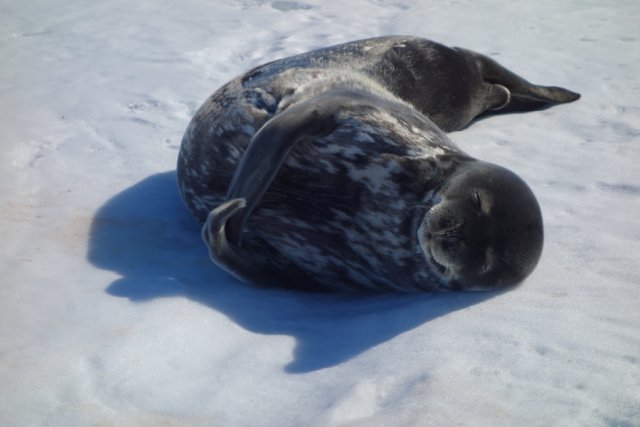
Weddell seal taking a little nap in the warm summer sun.
From another direction in the far distance, a cawing and chattering could be heard. Emperor penguins, brave creatures about one metre tall, that defy the harsh environmental conditions in Antarctica. They usually stand in groups at selected spots, proudly displaying their black and white tailcoats, observing the scene or looking after their offspring at this time of year, while their wild conversations reach deafening levels. In contrast, they appear somewhat droll as they go about their business. Either they waddle leisurely, their whole bodies swaying from side to side, at a snail's pace across the ice, or they shift into second gear, lie on their bellies and propel their slide with paddling feet. It is impressive what speeds they can reach with this. They also have nothing to fear on the ice, which is why they showed no shyness towards us.
After some time of rest to regain a little energy, we started to make ourselves at home, set up our camp beds and make ourselves comfortable for the first night on the ice. It should be enough for this day and we postponed the rest of the work until the next day. Completely exhausted, I slipped into my sleeping bag, which alone was supposed to defy the cold, but I still had to put on long underwear, thick woollen socks and a hat for a warm, comfortable sleep. This made it possible to endure the minus ten degrees in the tent. I was ready for the all-night time machine, I set the arrival time for early morning the next day, closed my eyes and began the journey.
5. On the first day
The morning needed a bit of getting used to. When I awoke from my marmot sleep, I was cradled in a cosy, warm cocoon. Only when my subsystems were gradually activated did I notice the icy cold on my face. A harbinger that prepared me for a frosty affair that now lay ahead of me. I decided to delay the encounter with the cold ambient conditions a little longer and dug in for the moment. But at some point my fate could no longer be postponed. So out of the sleeping bag - a temperature shock after which you almost didn't need a good-morning coffee - and into the high-tech clothes, which were as cold as if they had been stored in the freezer overnight.
There was still a lot to do, we explored the surroundings and prepared everything for our work. This involved forming a rope team, as we had learned in the Alps, to find a way for the snowmobiles and our equipment from the ice shelf to the sea ice twenty metres below. This was found relatively quickly and we marked out the routes with bamboo poles with black flags attached to the end. These utensils, which at first seemed inconspicuous, were, however, among the most important objects in our luggage. Without these markers we would probably have been quite lost, but more about that later. The camp was slowly taking shape. I had my tent with workshop and sleeping facility. There was a spherical GRP igloo (a red tomato) for Horst and Dominik. A baguette roll-shaped igloo as communal accommodation where we ate and spent the evenings. Richi had taken a closed plastic sled. How he managed with so little space was a mystery to me, but in the end it only served him for sleeping. We erected a Scott tent as a retreat for private business. It was even equipped with a proper toilet, which made necessary conferences more pleasant. Horst had set up another tent for his equipment and research preparations. A generator bank was installed for the necessary energy demand, from which cables led to each dwelling. We mounted them on our bamboo flags at a height of about two metres, pulling lines in all directions of the camp. These served another purpose at the same time, helping us to get from one place to another without losing our orientation. This is not a problem in good weather, but when the visibility gets cloudy, the wind picks up and takes the loose snowflakes from the surface with it, a snow drift arises that can easily take on dimensions that reduce visibility to a few metres. When this happens, it is fatal to start walking without a point of reference. The inner compass fails immediately, your own tracks are no longer visible within a very short time and finding your way back to the starting point becomes a deadly game of chance. If, for whatever reason, you get into such a situation, there is only one option. Do not leave the place and hope that visibility improves again before you are frozen to a block of ice. Once all the lines were laid, it looked a bit like a South American suburb, with everyone criss-crossing their power supply regardless of order. The vehicle fleet was parked in front of the camp and a fuel store was set up some distance away. There was petrol for the generators and snowmobiles, gas for cookers and the already mentioned paraffin for an evacuation. Last but not least, all items that were stored outside had to be marked out with our flags, because a snow drift would bury them underneath and they could then no longer be found.
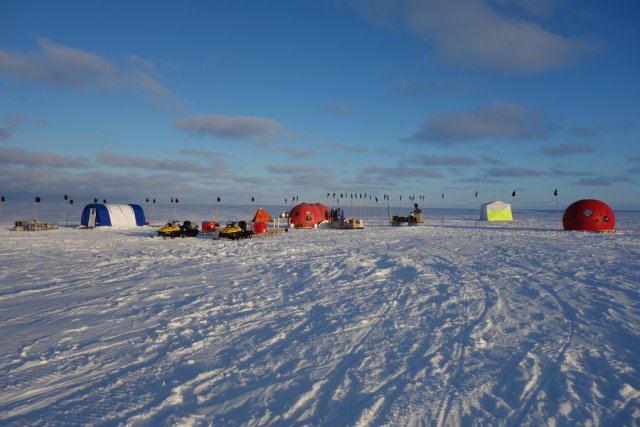
The headquarters at Drescher Inlet.
After I had established my workshop and Horst had prepared his research, we could finally begin our project and dedicate ourselves to our mission. As every morning, we had warm coffee, an invigorating breakfast and our daily planning meeting to discuss the day's plans. Horst made his morning check call to the Neumayer station and got the weather forecast. There were no surprises to worry about, so we were ready to go. We saddled up the snowmobiles, which meant refuelling, hooking up Nansen sleds with survival boxes and stowing all the necessary equipment for the day. We would explore Drescher Inlet, scouting out routes across the ice and the myriad cracks, stopping by the seal sites and drilling test holes for the ROV. I have to admit that at first I was a little uncomfortable sliding around on the sea ice with the relatively heavy equipment, but after the first hole I realised that the ice was much thicker than I had expected. We gave up after two metres, as it seemed impossible to get a big enough hole in the ice with the tools at our hands. Even a jumbo jet could have landed on such thick ice. The cracks in the ice, however, were a completely different story; they turned out to be quite insidious. The dynamics of the tides and the resulting movement of the ice plates resulted in a pulsating opening and closing of the veins criss-crossing the surfaces. A crossing that in the morning was almost invisible and not even worth mentioning could later become an insurmountable obstacle. So we marked the most promising spots with two flags, gradually creating a safe network of paths through our new territory. A breathtaking scenery, huge ice plains that changed in texture finally ended at the ice shelf wall which borders the Inlet. The wind had driven snow, accumulated drifts and sculptured the upper edges of the ice walls. Some towering walls resembled a cream meringue pie and made my mouth water. High snowdrifts formed almost natural transitions onto the ice shelf in some places.
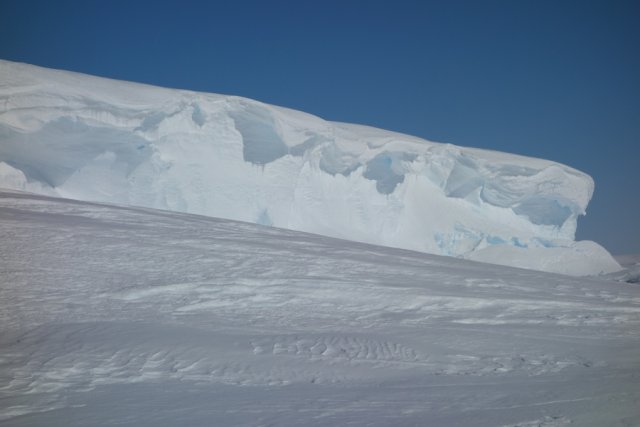
The ice shelf edge from the perspective of the inlet. Wind and snow brought the most bizarre shapes to light, some of which reminded me of delicious cream meringue pies.
We slid over mirror-like surfaces, always hoping not to lose control of our vehicles. But again and again came rougher or snow-covered surfaces on which much more grip was to be expected. The most exciting part was the ascent and descent from our higher camp onto the sea ice. At least there was a ramp that allowed us to do this manoeuvre, but it was still very steep and slippery, but somehow we always managed to get the several hundred kilos of equipment up or down there. Well, we were on our first exploration tour and suddenly it happened. I was the lucky one that day, having apparently chosen the wrong snowmobile. As if out of the blue, the machine abruptly started to stutter and eventually failed to work. Unfortunately, it didn't stop there, because the next moment the thing also started to burn. It's not quite as dramatic on frozen water, because if there's one thing you can't do in Antarctica, it's get a fire burning permanently on the ice. So we quickly had the fire under control. Fortunately, no harmful substances were released into the environment, but the sledge was ruined. Finally we were able to drag it back to the camp, where its fate as an organ donor was sealed for the time being. Later we found out that the screw holding the cooling fan in place had loosened and the engine had simply become too hot, which eventually ignited the insulation under the bonnet.
6. New day, new luck
It took a few attempts before we actually found a suitable spot where the ice was only about one and a half metres thick, which was just within the range of what was feasible. We had made it to about half of the approximately ten kilometres to the coast. The position was perfect, it was only about thirty metres from the edge of the ice shelf towering in front of us. There was a large crevasse where there were some seals and we were pretty well protected from the vagaries of nature. Here we would set up our outpost and establish an ROV base. It was going well and we were even ahead of schedule, so we decided to head home and finish the evening with a hearty meal. The following day we would start work on the ice hole.
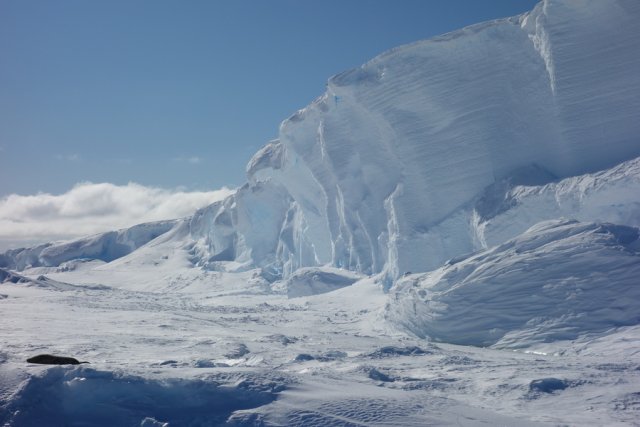
The ice shelf wall at the ROV operations centre, on the northern flank of Drescher Inlet.
The following days were hard and exhausting. We had a cordless screwdriver for the five-centimetre-thick ice drill, two ice saws and a couple of ice picks at our disposal. If someone had told me beforehand what I was getting myself into, I probably would have thought twice. The ice hole project turned out to be much more time-consuming than expected. Alternating between drilling and sawing, we made slow advances and spent days and days gnawing, drilling and sawing our way through the stubborn ice, but we made progress.
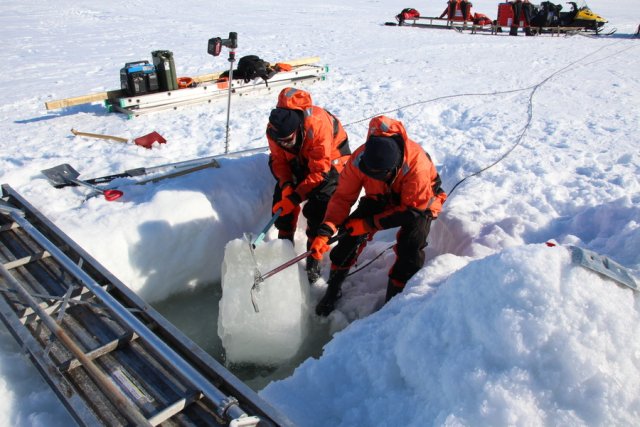
Working at the ice hole. After we had finally loosened a piece of ice with the drill and saw, we could pull it out of the water with the ice picks. Picture: Domink Nachtsheim
After a few days, we finally pushed through the ice cover and were horrified to find that a layer of platelet ice had accumulated underneath. Platelet ice is a phenomenon that forms in the water column and then floats to the surface. The Antarctic waters are home to the coldest water masses on our planet; the high salt content of the seawater allows temperatures as low as minus two degrees without freezing. If melt water from the ice shelf or water layers with a lower salt content now hit these extremely cold water masses, they immediately freeze to form chip-shaped ice plates several centimetres in size. Due to the lower density, these then drift upwards. If they meet an ice sheet at the end, they form a crunch ice-like layer that can be several metres thick. It was not particularly difficult to loosen the quite porous conglomerate of the platelet ice with poles and weights that we dropped into the depths on a rope. They then floated to the surface and could be scooped off with a shovel. However, it turned out to be a six-metre thick layer and it took us another few days to painstakingly remove it. Then it was finally done. Unexpectedly, our tools pushed through the last layer and opened the shaft into the sea. To our greatest surprise, something happened that we never expected. Suddenly the noses of young seals appeared in our ice water pool. They had taken the opportunity and realised the great potential of our long and hard work. Immediately the seals had chosen our ice hole for their bathing fun. Although we had to argue with them daily about the rights of use, in the end it was a successful symbiosis, they kept the hole ice-free and were allowed to have their fun while we pursued our work. In the end, it was a win-win situation.
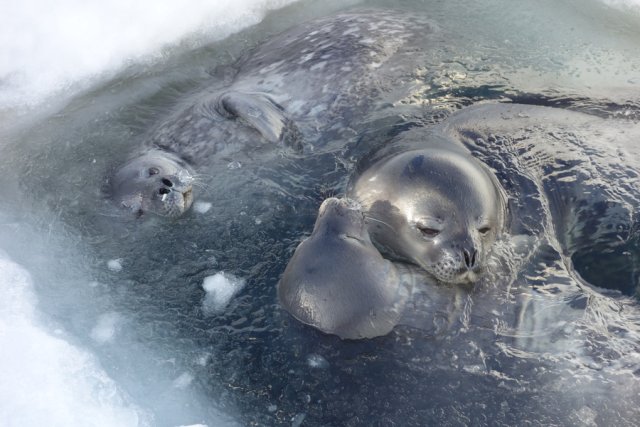
Young Weddell seals having fun swimming in the ice hole.
When good opportunities arose, we followed Horst's mission and tagged one or the other seal, again with everyone helping each other out. Only adult animals were selected, as the younger ones were still too small for the burden of carrying a transmitter. It should be mentioned that the transmitters are glued to the fur and fall off at the next coat change, so no permanent restriction.
The ROV operations centre was set up and we could tackle the first test dive.
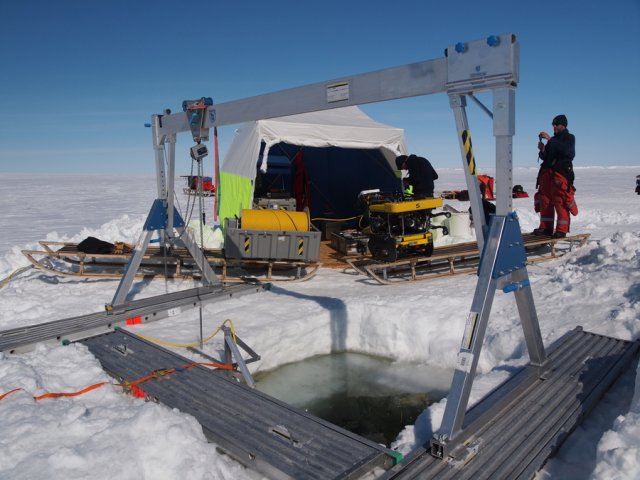
ROV station in Drescher Inlet. Image: Dominik Nachtsheim
Unfortunately, it wasn't long before we had the next setback. It turned out that our equipment suffered greatly from the low temperatures. The minus two degrees water temperature was not yet crucial for the functionality, but the air temperature of up to minus fifteen degrees gave the rubber seals a hard time. While on missions from the ship, the equipment is only exposed to the outside temperatures shortly before the mission, the situation is somewhat different here. The water is much warmer than the outdoor conditions and the technology is not designed for this temperature range. Seals failed, leading to water leakage and eventually a short circuit in the electronics. I had taken enough spare parts with me and was able to repair the damage, but each time it involved hours of repair work, during which my fingers and even my nerves froze. The days went by and we carried out one attempt after the other. To the displeasure of my colleagues, I insisted on repacking the unit every evening and pulling it back to the base on the sledge. Admittedly, this was a lot of extra work and cost a lot of energy. I also understood the argument that there was probably no one here who would tamper with it during the night. My concern was more the risk of changing ice conditions. Cracks could have opened up so that we could no longer reach our outer camp. In the worst case, the tides could carry away the ice floes with all the equipment, never to be seen again. A relatively small risk, but nevertheless my perseverance was to pay off. The catastrophe then came unexpectedly from a completely different direction.
7. The storm
Uncomfortable wind conditions were forecasted for us, so we should be prepared for thunderstorm-like conditions. Therefore, we checked once again that everything was staked out with the marker flags and that all loose objects were stowed away. Wind was picking up, but nothing to worry about yet. I had just turned in for the night, curled up in my sleeping bag and listened to the thunderous sounds of the wind and blowing snow scuffling with my tent. A short time later, I sank into the depths of the space-time continuum of a cosy sleep. Something was wrong - my face became icy - I noticed light drifting snow above me. Wait - snow in the tent did not bode well, then the noise of the storm also grew louder and I realised that the tent above me was slowly disintegrating into its components. As if stung by a tarantula, I slipped out of my safe cocoon and saw the back half of the tent roof being peeled off by the wind. Now hecticness came into play. First I had to get into the thermal suit and ensure my own heat balance. My second thought was to leave the tent and get help, but then I noticed that thick snowdrifts were blocking the exit and the door wouldn't open an inch. What a stupid construction. I am aware of the advantage of an entrance door that opens to the outside, but a traffic jam caused by panicking people fleeing is not to be expected in a tent. Back to the problem, because the wind was not only working on the tarpaulin but also on the tent poles and that was the second weak point of this construction. The poles were only inserted into each other and held together by the tension of the tarpaulin. I don't need to explain the consequences of a missing cover. The parts fell down one after the other and I was threatened with a total loss of my accommodation. In the meantime, there was already a layer of snow several centimetres thick on everything I held sacred. There was no time to waste and I had to think of something as soon as possible. In no time at all, I rummaged various tension belts and ropes out of the chaos and began the sweaty reconstruction of the remaining tent roof. Unfortunately, it was not possible for me to get outside to freedom, at least without destroying the tent. So I could literally throw a possible request for help from my colleagues to the wind. Meanwhile, the storm had picked up speed and my work was always two steps forward and one step back. I collected parts, braced poles, built pulley systems to drag the tarpaulin back over the frame against the wind. My strength was slowly failing and I began to fear that I might lose this rescue operation. But somehow I managed to regain the upper hand and the rebuilding of my dwelling progressed slowly. In the end, I got the tent mostly tight, but the heartless storm shook and rocked my improvised construction so that I had to fear a failure of my guy ropes. Sleeping was out of the question anyway, so I brought some order into the chaos. I emptied a few aluminium boxes that served as storage space for the snow piled up in the tent. After a while, however, a relentless exhaustion set in and I sank down on a chair and just watched, hoping that my makeshift construction would hold and waiting for something to happen. I don't remember if I fell asleep in between, but my vital condition did not indicate much recovery.
At some point there was a knock at the door. Richi, unaware of what I had been through during the night, asked with a slightly amused tone if he should shovel me out of this predicament. The question seemed a bit superfluous, but I agreed. Freed from my frosty prison, I stepped out of the tent. The storm had subsided and a warm sunshine brightened my mood. I took stock of the situation, which made it unmistakably clear that we were in for a hard day of snow shovelling. I met the rest of the group at breakfast, already sipping their coffee, completely unaware. From now on, no one was to go to bed without the radio on, because that was one of the big mistakes that put me in this predicament. Now began days of rebuilding the camp. Snowmobiles, food and various other stuff had to be freed from their white burial mounds. We reworked my tent and carefully stretched everything. The fine powdery snow, almost dust-like, crept into every gap it could find. But that also meant that it was to be found in everything I pulled out from under the masses of snow in my tent. Eventually I had to dismantle everything, all the computers, the entire deck unit of the ROV systems and all my personal belongings. At least I didn't have to expect melting snow, as temperatures here never rise above zero degrees Celsius. In the end, it took me three days to disassemble each piece of equipment, dry it with a hairdryer and, hoping that everything still worked and put it back together. After the work was done, we could tackle the next visit to the diving hole. There, however, a much more dramatic picture awaited us. The hole was closed, the operations centre was bent half to the side and full of snow up to the roof. Now my wise foresight paid off, because fortunately not a single bit of electronics was buried under the damp, frozen snow. The screens, recorders and control units would probably not have survived. Another day was wasted on repairs, but eventually we got everything back under control and were able to resume our research mission.
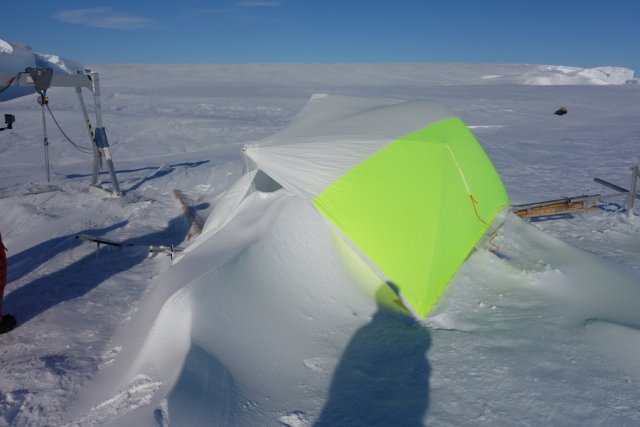
The ROV station destroyed by the snowstorm.
8. Dive into the unknown
With much more repair time than dive time to keep the sub-optimally functioning ROV operational, we were able to make some successful dives to and under the ice shelf. We found the creatures under the ice, or the hanging gardens as we called them, and were even able to take a few samples. Even the descent into the water was extremely exciting each time. As soon as the ROV was let off the hook and the last system checks were carried out, we knew whether we were going down or back to the workshop. Along the seven-metre-deep shaft, through which the ROV could just fit, the metre-thick layers of plate ice came into view of the cameras. But then the view opened up and revealed the underside of the ice. Even the nearby crack that the seals used for entry and exit was clearly visible. The USBL, which allows us to determine our position underwater, was just barely sticking out of the hole, and we had already screwed together all the poles at our disposal to reach this depth. I set course for the ice wall ahead and off we went into the darkness of the sea. It was an thrilling dive because, unlike my previous missions, there was no escape to the surface. The ROV is always trimmed slightly positive, so that in case of failure it comes back to the surface on its own, but here an incident would mean the loss of the vehicle. With extreme caution, I manoeuvred the ROV towards the ice shelf wall protruding into the depths. As soon as the ice came within range of the spotlights, the deep black image changed to a progressively lighter grey, until finally clear structures of the ice surface could be seen. A surface shaped by the currents was revealed to us, consisting of a mosaic of depressions about twenty centimetres in size. From a distance, these structures looked like the surface of a golf ball. These typical melting holes are created by turbulence in the water flow. As soon as the ice has melted and a small depression is formed, a self-organising process begins. Further eddies form on the basis of the depressions, which enlarge them until a kind of honeycomb structure has formed. This is basically a similar mechanism to that which gives rise to the elongated ridges in the sand on the beach. Already here we encountered the organisms we were looking for, thousands of them were hanging on the surface. They clearly preferred the protruding tips and ridges, which probably brought them closer to their food source in the current. They were isopods, crustaceans that filter tiny particles out of the water incessantly. After a few close-ups, I began the further descent, after all, we wanted to get beneath the ice and explore the underside. At a depth of about a hundred metres, we encountered a clear, right-angled edge where it went from vertical to horizontal without transition. I turned the ROV on its back as the cameras and sensors tended to still be oriented downwards. This made the underside of the ice appear in the camera image as if we were hovering above the ground. On the bottom of the ice we discovered countless more of these isopods, the entire colony had to consist of millions of individuals. Most were sitting upright on the raised parts of the ice, their upper bodies tilted downwards at ninety degrees. On a closer look, we discovered small black dots appearing in groups. These were offspring of the crustaceans, which can grow up from five to ten centimetres in size. Not surprisingly, there were far more of them than of the adult specimens. It seemed rather unlikely that we had been looking in exactly the right place by chance, the population was likely to have spread over a much larger area. Before heading back up, I flew a transect about a hundred metres long over the ice to be able to determine the population density later.
Horst also got his money's worth. We had equipped various seals with transmitters for tracking and were also able to place some cameras on the seals. However, this had the disadvantage that data transmission via satellite was not possible due to the large amount of data. So we were forced to track the seals again and retrieve the cameras. Thus, we often roamed the area to identify the bearers of our precious images, always hoping that they had not left the bay. We actually managed to get some cameras back, downloaded the data and prepared them for the next mission. The images were not comparable to those of the ROV due to resolution and lighting. The images were not comparable to those from the ROV due to resolution and illumination. Nevertheless, we were able to find our isopods on some of the pictures.
On another dive, I used a device I developed specifically for this purpose to take samples. Horst called it the benthos broom (benthos is the name given to everything that lives on the seabed or, as here, on surfaces in the water). It consisted of a small cage with a fine-meshed net and a narrow brush attached to the end. The whole thing was stretched on a frame and attached to the top of the ROV. I also set up a camera that showed the view of the broom to better coordinate the collection of the animals.
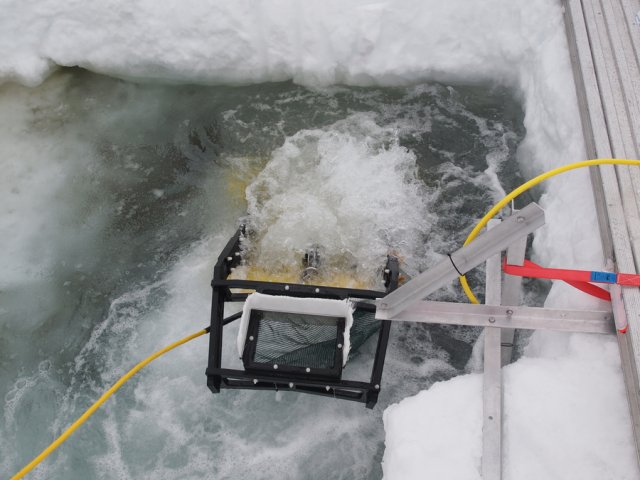
Dive under the eternal ice to take samples of the crustaceans living on the ice with the benthos broom. Picture: Horst Bornemann
The benthic broom worked amazingly well and we caught about a dozen individuals. This was not very much but it should be enough for a DNA identification. Unfortunately, the harsh conditions of nature took their toll on the equipment and this was the last successful dive into the world of the ice isopods.
We attempted another dive to the seafloor, but the generator failed, causing the system to abruptly stop working without power. The big danger was that the ROV would float up under the ice due to its slightly positive trim, get caught somewhere and thus be lost. To prevent this, we quickly pulled on the cable, which had already been left out for several hundred metres, in order to bring the system swiftly back towards the ice hole. After half an hour of hard labour, the ROV finally appeared in the hole and it was a big weight off my mind. It was one of the last days of our trip anyway, so we decided not to do another dive. Besides, we still had a lot of work to do with the dismantling. We had what we were looking for and I didn't want to risk the equipment in the last few moments. Sometimes you have to recognise the signs and know when enough is enough.
9. The way home
We began to pack our things, dismantle everything again and prepare for departure. It was a huge pile of stuff that had to be taken apart again, put into boxes and made ready for transport. Once again, you feel the power of entropy. Unpacking and creating chaos is quite easy, but getting everything back in order so that it fits into the boxes again is very time-consuming. On the second to last day, we were visited by a small Adélie penguin who spent half the day inspecting the camp. Our guess, the black flags played a trick on him from a distance, which is why he thought the camp was a penguin colony. Surprised by the things that awaited him here, he roamed curiously from tent to igloo, examining every object and watching us at work. But there was no sign of shyness on his face.
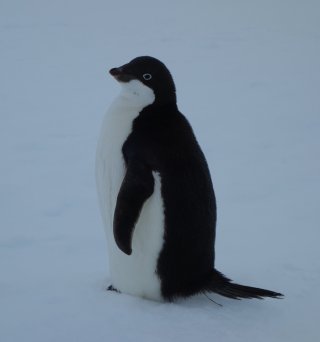
An Adélie penguin who paid us a visit at camp on the second last day.
The next morning, the Polarstern came into view and a little later the helicopters. Now the whole game began again in reverse order.
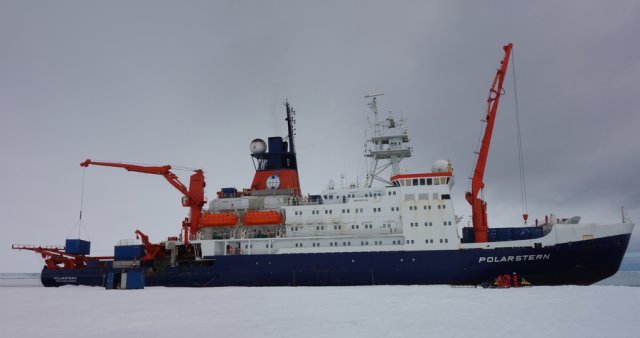
The Polarstern, moored at the edge of the ice, about to pick up our cargo again.
We took everything we had with us back. According to the environmental guidelines, it is not allowed to leave even the smallest thing behind. And by everything I really mean everything. We had even collected our personal leftovers, packed them in buckets and made them ready for departure. Everyone who owns a dog knows that this is not one of the most pleasant tasks. Back on board of the Polarstern, when the stress subsided, I recognised for the first time what an impact the time on the ice had. I realised why many explorers and adventurers look the way they do. When we let the raw forces of nature run free, when we don't keep them under control, natural chaos takes over and shapes their faces according to its own rules.
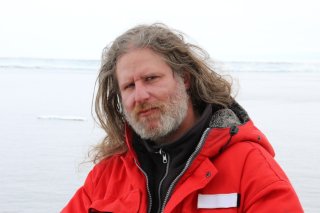
When we give nature its free hand. Image: Dominik Nachtsheim
The weather changed and we were not able to get everything back to the ship in one day, so our stay in front of the inlet was extended by another night. The next morning we finally managed to pick up and stow the rest. So without further delay we set off on our way home, which would keep us busy for another few weeks. As the Polarstern had a rendezvous with the port of Punta Arenas in the Strait of Magellan and would therefore soon be turning west towards South America, they could only take us a short part of the way. The very next day we had to pack our belongings again. This time the two helicopters took us in a flight of about an hour to the Finnish research station Aboa, which is located right next to the Swedish station Wasa on a rocky hill about a hundred kilometres inland. Not only we, but also the Finns had prepared for a longer stay. As Scandinavians go, the sauna was already heated up before we even landed. We were greeted with a warm welcome and a soothing hot soup for lunch. Far from the coast, it is rare for anyone to pass by here, and the change of our presence was a delight to many minds. Unfortunately, we only just made it to the station for a tour. The weather forecast was worsening and the time was gradually approaching the end of the season, which meant that everything that could be done did not get a postponement. Spontaneously, our administration decided to send one of our polar aircrafts, the Polar 5, from Neumayer to Aboa to pick us up before the weather conditions no longer permitted a flight. So we were collected again a few hours after arrival. So just a quick goodbye before we were taken down the hill to the airstrip in one of those monster truck-like pickups with super balloon tyres. The return flight to Neumayer was again extremely noisy in the DC3, so we had to put foam plugs in our ears, as we did on the outward flight. Although we would have liked to stay a few days on Aboa, I could well understand the need of the people in charge to get us out of here quickly. We still had a few days, but we were booked on one of the last Ilyushin flights back to Cape Town, and if we missed it, everything would be messed up. After all, we still had to get to Novolazarevskaya. It took about another week, during which we had to pass the time at Neumayer station. Horst already prepared a presentation of our experiences and gave an exciting talk about it, Dominik took care of his work and Richi and I supported the station maintenance as best we could. But then the day of farewell came here as well, whereupon we were squeezed into a twin-engine Twin Otter loaded to capacity to take us back to Novolazarevskaya. But the plane was so heavy that we didn't make it to the Russian station on one tank of fuel. There was a short detour to the Norwegian station Troll, where we refilled. The Norwegians chose a grandiose panorama at the foot of a mountain range for their station, with its dark mountain peaks rising above a white landscape. The flight along the rugged rock faces offered an impressive view, which made the flight - at least felt - much shorter.
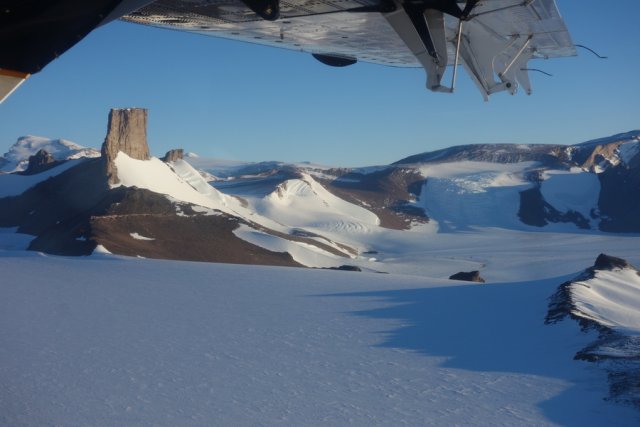
View of the mountain range of New Swabia on the way from Troll to Novolazarevskaya.
In the end, we had to spend another night in a container on Novolazarevskaya before we were flown back to civilisation and the world of colour in Cape Town. Again, we had one more day, which gave us the opportunity to make a short detour to the Cape of Good Hope. It was a strange sight to see the penguins waddling here on the beach at about thirty degrees in the shade.
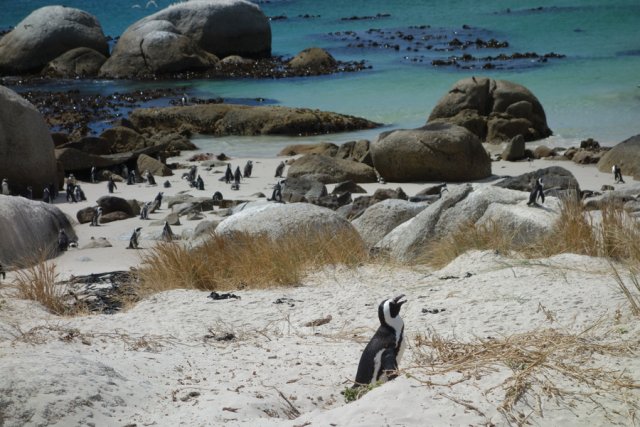
Penguins on the coast of South Africa.
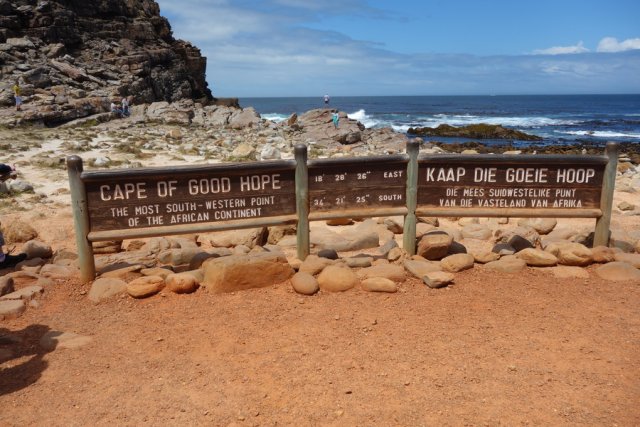
The famous and probably one of the most photographed signs in the world at the Cape of Good Hope.
A short time later we were on another adventurous flight home. Something was wrong with the port engine, it sounded like someone sticking a pencil into an old tin fan. I pictured the engine blades ripping themselves off the hinges and perforating the hull of the aircraft. My worry did not seem entirely groundless, as the flight attendants only replied with somewhat abstruse jokes to my enquiry as to whether there might not be a small defect. In my experience, people only do that when there is actually a reason for concern. Some of my colleagues had also lapsed into an icy freeze, which didn't make the situation any better. When we had to fly two extra turns around our destination and the airport fire brigade was getting ready, I also felt a bit queasy in my stomach. But they were probably getting ready because of the snow-covered runway, which also looked a bit icy. Anyway, we landed with a loud roar from the turbines, which were switched to full thrust reversal. While the brakes were noticeably gripping, the end of the runway was getting dangerously close. Through the windows, the blue lights of the rescue teams on the airstrip flashed. It was only a few metres to the embankment at the end of the runway before the plane turned away to the right, heading for the airport. A palpable sense of relief spread through the cabin, and the flight attendants also visibly seemed to be relieved. Finally back home - overjoyed to have made it back unharmed, my only regret was the missed opportunity to climb the Annakogel at night.
Epilogue
After weeks away from civilisation, you notice the unpleasant smells we are exposed to in everyday life. The air in Antarctica is so clear and pure that there are virtually no germs or other traces of organic molecules in the atmosphere. In fact, the immune system suffers from the absence of any challenge, so it is not uncommon for returnees to fall ill in the first few days after arrival. I was spared that fate this time, which may also be due to the fact that I didn't get up from the sofa for what felt like a week and just let my soul dangle. It was a good journey with many challenges that often pushed me to my limits. But despite all the hardships, it was an unforgettable adventure. To get along with a small group alone in a very limited space for so long without conflict is not natural and requires a lot of discipline as well as a high tolerance threshold. Not once did we seriously clash, even if there were disagreements now and then, frustration about inclement weather and malfunctioning technology spread, or pure exhaustion made us act irrationally. In the end, we had everything under control, which is not a matter of course in such extreme situations. After all, we all grow with our tasks and yet are much tougher than we first think.
Further reading
Owsianowski, N. et al. (2017): Under-shelf ice sampling by ROV reveals specimens of ice-associated crustaceans
Owsianowski, N. et al. (2018): Under-shelf ice video footage and hydrographic data from ROV transects at Drescher Inlet, PANGAEA
Knust, R. and Schröder, M. (2014): The Expedition PS82 of the Research Vessel POLARSTERN to the southern Weddell Sea in 2013/2014
Gutt, J. and Dieckmann, G. (2021): The Southern Ocean: an extreme environment or just home of unique ecosystems? / G. di Prisco , H. Edwards , J. Elster and A. Huiskes (editors) , In: Life in extreme environments - Insights in biological capability, Ecological Reviews, Cambridge, Cambridge University Press, 16 p., ISBN: 978-1-108-72420-3
Blog by Dominik Nachtsheim About Weddell seals and ROV
Wikipedia: Drescher Inlet
last update: 25 Oct 2023 17:47
